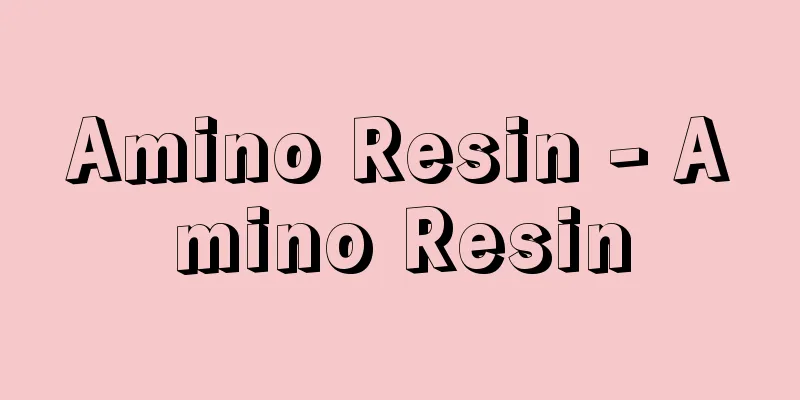Coffin

|
It is a container for placing a buried body, and is distinguished from an urn for placing cremated bones. When a body is placed in a double container, it is distinguished as an inner coffin (hitsugi) and an outer coffin (kaku), but originally it referred to a container for directly placing a body. Burial of bodies has been practiced since the Paleolithic period, but the use of coffins is thought to have begun in the Neolithic period, when agricultural societies were established, as a result of the combination of reverence for the dead and ancestor worship. However, when buried in the ground, the body was not necessarily placed in a coffin; as can be seen in medieval stone-collected tombs and pit tombs in Japan, the body was often buried directly in the ground. [Terashima Koichi] Coffin classificationCoffins have been used all over the world since ancient times, but their shapes and structures vary widely depending on the region and time period. They can be classified by material, such as wooden coffins, stone coffins, ceramic coffins, clay coffins, metal coffins, and dry lacquer coffins, and by shape, they can be divided into box-shaped coffins, boat-shaped coffins, and house-shaped coffins. They can also be broadly classified by how the body is laid in them, into sitting coffins and lying coffins. It is generally believed that there are three lineages for the origin of coffins. One is when infants and other such bodies were buried in everyday jars, as typified by the joint-mouthed jar coffins of the Yayoi period. The other type was when people were forbidden from burying their bodies directly in unearthed pits, and so were buried in chests made of stone or wooden boards, as exemplified by the split bamboo-shaped wooden coffins found in Japanese ancient tombs. The other type was when the walls and ceiling of the pit were surrounded by flagstone or wooden boards, as exemplified by the assembled stone coffins. [Terashima Koichi] Ancient Orient and EuropeIn the Near East, infants were buried in jars during the Neolithic period. In Mesopotamia, bodies were found buried in extended burial pits made of sun-dried bricks. In Ur, the Babylonian capital of the Early Dynastic Period, there are clay coffins, wooden coffins, and coffins made of reeds and willow branches. In Egypt, composite wooden coffins were made from the Second Dynasty onwards, but from the Third Dynasty onwards, stone coffins made from megaliths were made in the pyramid era. On the other hand, wooden coffins beautifully decorated with paintings and patterns were also used, and from the Middle Kingdom onwards, wooden mummy coffins were made. The inscriptions written on the inside of these wooden coffins are good evidence of Egyptian religion. The Egyptian tradition of stone coffins influenced the peoples along the Mediterranean coast, and distinctive ceramic and stone coffins were made in various places. The "Sarcophagus of Alexander the Great" excavated in Sidon (Saida) (held at the Istanbul Archaeological Museum) is said to be the most artistically valuable sarcophagus from the Hellenistic period. This sarcophagus is in the form of a temple, and the scenes of battles between the Greeks and Persians are particularly famous. In Rome, simple stone sarcophagi were used at first, but by the time of the Empire, extravagant ones decorated with high reliefs were made. Many sarcophagi made in Rome and northern Italy were exported to the western provinces. An early example is the sarcophagus of Scipio Barbatus, and a later, more elaborate one is the sarcophagus made of granite of Constantia, the daughter of Emperor Constantine the Great. Since Christianity forbade cremation, early Christians used simple but beautiful stone sarcophagi carved with portraits of Christ and the apostles. In the Middle Ages, following the trend towards simple burials, simple wooden coffins were used. During the Renaissance, as culture as a whole rose to prominence, extravagant stone sarcophagi and bronze coffins were made. Of these, the coffin of Giovanni Medici, made by the Italian Donatello, is famous. [Terashima Koichi] ChinaIn the Neolithic period in China, in the Central Plains, burials of infants in earthenware jars were common, but adult bodies were buried directly in pits. However, in the northeastern region, box-shaped stone coffins were used. During the Yin dynasty, wooden coffins began to be used, and assembled wooden coffins were discovered in various places during the Spring and Autumn and Warring States periods. Coffins with lacquer coating on the inside and outside and those with silk belts already appeared. In the Han dynasty, rectangular combination wooden coffins were used as in the previous dynasty. Many of them were about 2 meters long and 60 centimeters wide and high. The most famous of these was Mawangdui Tomb No. 1 in Changsha, which was excavated in 1972. In this tomb, four nested wooden coffins were found in a double chamber. The outermost coffin (2.9 meters long) was painted black lacquer, the second was painted black, and the third was painted red. The innermost coffin was ornate, with silk belts wrapped around it in two places after the lid was closed, and brocade was pasted on the lid and the outer walls around it. The four coffins were all exactly the same rectangular shape, and the insides of each coffin were painted red. The inner coffin was 2 meters long, and the maximum length of the chamber was 6.7 meters. During the Later Han Dynasty, coffins with a high and wide head and narrow legs became common. This type of coffin style has continued through the Tang Dynasty and continues to this day. In China, as can be seen in Mawangdui Tomb No. 1, the preservation of the body was given great importance, and coffins are said to have played an important role. Therefore, many coffins were made before the deceased's death and were carefully finished. In Korea, during the period when stone and metal were used together, many box-shaped stone coffins were built inside dolmens. In the southern part of the country, earthenware coffins were also used. Since then, stone and earthenware coffins have been used occasionally, but wooden coffins are more common. [Terashima Koichi] JapanIn Japan, during the Jomon period, large jar coffins with stone lids and jointed jar coffins made by joining the rims of two jars were used. During the Yayoi period, jar coffins were used in large numbers, especially in the Kitakyushu region. In addition to jar coffins, box-shaped stone coffins made of combined stone slabs were made from the end of the Jomon period to the Yayoi period. Large ones that could hold several bodies have been discovered, especially during the Yayoi period. During the Kofun period, many different types of stone coffins can be seen, including split bamboo-shaped stone coffins, boat-shaped stone coffins, house-shaped stone coffins, and chest-shaped stone coffins. Wooden coffins have continued from the Yayoi period to the present day. During the reign of Emperor Kōtoku (reigned 645-654), it was decreed that coffins for subordinates should be made of wood, and stone coffins gradually fell out of use. One of the most famous surviving wooden coffins is that of the three generations of Fujiwara at Chusonji Temple in Hiraizumi, all of which were beautifully made with gold leaf applied over black lacquer. However, this type of lying coffin was used by the upper classes such as aristocrats, and sitting coffins were generally used even after the Middle Ages. It was only after the Meiji period, when hearses and cremation became widespread, mainly in cities, that common people began to use lying coffins. [Terashima Koichi] Anthropological aspects of coffinsAccording to anthropologist Van Gennep, the funeral process can be divided into three stages: separation rites, transitional rites, and integration rites. Among these, the coffin appears as an important element in the separation and integration rites. In separation rites, that is, the actual procedure of separating the dead from the living world, placing the body in the coffin or closing the coffin lid often marks the solemn end of the entire ritual. For example, in the society of the Hanunu Mangyan people of the Philippines, the body is placed in a non-unclean north-south direction until the moment of burial, and the procedure is carried out as if the body were alive, but when the body is burial, it is moved to the east-west direction, which is considered the direction of the dead, and the funeral process is also carried out by breaking down part of the wall of the house. This means that the ambiguous state between death and life is transformed into a ritually dead state through burial, and at the same time, the hole in the wall can be interpreted as a symbolic space that separates this world from the next. Let us consider the case of integration rituals. This generally comes from the meaning of completely integrating the dead into the world of the dead and the relatives of the dead into the world of the living after transitional rituals such as mourning. In the society of the Gaju Dayak people in southern Kalimantan (Borneo), the dead are first placed in a temporary coffin and buried on a hill far up the river (first funeral), and when the financial resources of the surviving family have increased to a certain extent, a grand Tiwa ritual (second funeral) is held. At this time, the dead are placed in a beautifully carved coffin. Thus, after this ritual, complete separation of the world of the dead and the world of the living is achieved. In the Tiwa ritual, the board depicting a boat plays an important role, but there are many instances of boats, funerals, and coffins in Southeast Asia and Oceania. Boat burials are one of them, but there may be problems with regarding the boat itself as a coffin. However, there are some notable examples where boat burials have become formalized and boat-shaped coffins are used instead of real boats. In the Melanesian islands of Malaita, New Caledonia, New Ireland, Ambrym, and Manus, the deceased is placed in a boat-shaped coffin, and in some places it is hung on a tree. Examples of boat-shaped coffins have also been reported in Samoa in Polynesia and on the island of Kusaye (Kosrae) in Micronesia, and all of these funeral methods are linked to the idea of an afterlife at sea. In Southeast Asia, there are examples of boat burials or boat-shaped coffins among the Batak, Pakpak, and Karo people of Sumatra, and among the people of Sulawesi (Celebes), Timor, Nias, and the Nicobar Islands. In mainland China, the Miao in southern China, the Kachin in Myanmar (Burma), the Ao in Assam, and the Lhota Naga people also use boat-shaped coffins. The wealthy northern Lhota Naga people are especially likely to be buried in boat-shaped coffins decorated with rhinoceros heads and tails at both ends. The Sadang Toraja people of Indonesia use wooden coffins. These are so-called boat-shaped coffins, cylindrical in shape, made by splitting a natural log vertically and hollowing out each piece. The origins of these boat-shaped coffins, which are widespread throughout Southeast Asia, are said to date back to the Dong Song culture that flourished before the Common Era, and they often appear in the decorative motifs of bronze drums, which are representative of that culture. However, also in Southeast Asia, the Minahasa people of northern Sulawesi, along with the Palau people in the South Pacific, use stone coffins. The indigenous peoples of North America (Native Americans) use wooden coffins and boat-shaped coffins, and in the Mayan culture of Central America, examples of nobles being buried in stone coffins have been found, although they were not as splendid as those in Egypt. In recent years, tombs of kings and elites in wooden coffins have been discovered in the central Andes of South America, along with a large number of grave goods. In the southern Andes and Amazon regions, earthenware coffins were also used. [Yuji Seki] Japanese FolkloreCurrently, or until recently, wooden sitting coffins are commonly used, and there are two types: tub coffins and box coffins. Box-shaped reclining coffins have been popular among the upper classes. As rigor mortis makes it difficult to insert the body into a sitting coffin, it was necessary to either have the body lean against a pillar immediately after death, or to tie it with a belt called a "gokuraku-nawa" (paradise rope) to give it shape. This may have been seen as too cruel, which was one of the reasons why reclining coffins became so popular. In northern Kyushu and parts of Chiba Prefecture, earthenware jar coffins were used until recently. They were made from kitchen water or tea jars, and it is not clear whether they had been used continuously since the Jomon period. Some legends describe those who prepare their own coffin while they are still alive as people with good intentions, but in most cases, coffins were made immediately after death. In Edo during the Edo period, coffins were called hayaoke (quick coffins) because they were made in a hurry after death. In village communities, funerals in general were managed by a neighborhood organization called the funeral group, so coffins were made by someone skilled in the village. They were made in the morning on the day of the funeral procession, along with other funeral equipment. Then carpenters began to be hired, and the service gradually became commercialized. When a carpenter was hired, a daily wage of one day was paid. When the body is placed in the coffin, the deceased is dressed in a sutra shroud and has a zuda bag placed around the neck. Inside the zuda bag are placed grains, six one-mon coins, and luxury items. The grains are said to be thrown to the deceased when they are chased by dogs in the afterlife, and the one-mon coin is said to be the fare to cross the Sanzu River. Luxury items include tobacco and alcohol for men, and sweets and sewing tools for women. Sometimes tea bags are stuffed into the coffin to prevent the body from moving. Nowadays, the zuda bag is often omitted, but items that were used and luxury items from the deceased's lifetime are still placed inside, and it is now fashionable to have the entire coffin decorated with flowers such as chrysanthemums. Nowadays, hearses are widely used to transport coffins to crematoriums and burial sites, but in the past, a funeral procession of two or four people carried the coffin. It is common for the gravedigger from the funeral team to wash their hands and feet after digging and then carry the coffin, and it is traditional for them to wear straw sandals. [Shoji Inoguchi] [Reference items] | | | | | | | | | |Source: Shogakukan Encyclopedia Nipponica About Encyclopedia Nipponica Information | Legend |
|
土葬の遺体を納める容器で、火葬した骨を納める骨壺(こつつぼ)と区別される。遺体を二重の容器に納める場合は、内棺(柩(ひつぎ))、外棺(槨(かく))として区別するが、元来は直接遺体を納める容器をさすものである。 遺体の埋葬は旧石器時代から行われているが、棺の使用は、新石器時代に入り農耕社会が成立して以降、死者に対する畏敬(いけい)と祖先崇拝が結び付いた結果、行われたと考えられている。もっとも、土葬の場合かならずしも棺に納められたわけではなく、日本における中世の集石墓、土壙(どこう)墓にみられるように、遺体をそのまま土中に埋葬することも多い。 [寺島孝一] 棺の分類棺は古くから世界各地で用いられているが、地域や時期によって、形態・構造にさまざまな変化がある。材質による分類としては、木棺、石棺、陶棺、粘土棺、金属棺、乾漆(かんしつ)棺などがあり、形態によっては、箱式棺、舟形棺、家形棺などに分けられる。また遺体の納め方による分け方として、座棺、寝棺に大別することもできる。 棺の発生は一般に三つの系統があると考えられている。一つは幼児などを、日常用いていた甕(かめ)などに納めて埋葬したもので、弥生(やよい)時代の合口(あわせぐち)甕棺などに代表される。一つは、素掘りの土壙に直葬するのを忌み、石や板製の櫃(ひつ)に入れて葬ったもので、日本の古墳にみられる割竹形木棺(わりだけがたもっかん)などがこれにあたる。もう一つは、土壙の壁、天井を板石や板で囲むもので、組合せ式石棺などがこれにあたる。 [寺島孝一] 古代オリエントとヨーロッパオリエントでは新石器時代に幼児の甕棺葬がみられる。メソポタミアでは日干しれんがでつくった墓壙中に伸展葬した遺体が発見されている。初期王朝時代のバビロニアの首都ウルでは、粘土棺、木棺、またアシやヤナギの枝でつくった棺がある。エジプトでは第2王朝以来、組合せ式木棺がつくられたが、第3王朝以後のピラミッド時代には巨石を用いた石棺がつくられた。一方で絵画や文様で美しく飾られた木棺も用いられ、中王国時代以後には木製のミイラ棺がつくられるようになった。こうした木棺の内側に書かれた柩文(きゅうもん)は、エジプト人の宗教を示す好資料である。エジプトにおける石棺の伝統は地中海沿岸の民族に影響を及ぼし、各地で特色ある陶棺、石棺がつくられた。シドン(サイダ)出土の「伝アレクサンドロス大王石棺」(イスタンブール考古博物館蔵)はヘレニズム時代のものとしてもっとも美術的な価値が高いといわれている。この石棺は神殿の形をとり、ギリシア人とペルシア人の戦闘の場面はとくに著名である。 ローマでは、当初簡素な石棺が用いられたが、帝政時代になると、高浮彫りなどで装飾した豪華なものがつくられた。ローマや北イタリアでつくられた石棺は、西方の属州に数多く輸出された。初期のものとしてはスキピオ・バルバトゥスの石棺が、後の煩瑣(はんさ)なものとしては、コンスタンティヌス大帝の娘コンスタンティアの玢岩(ひんがん)製の石棺が著名である。キリスト教では火葬を禁じたため、初期キリスト教徒は簡素ではあるが、キリストや使徒の肖像などを刻んだ美しい石棺を用いた。中世は薄葬の風(ふう)にのり簡素な木棺が使用された。ルネサンス期には文化全体の高揚に伴って、豪華な石棺や青銅製の棺がつくられた。このうちイタリアのドナテッロ作のジョバンニ・メディチの棺は著名である。 [寺島孝一] 中国中国では、新石器時代の中原(ちゅうげん)一帯では、幼児の甕棺葬は行われていたものの、成人の遺体は土壙に直葬したと考えられる。しかし、東北部では箱式石棺が用いられていた。殷(いん)代に入ると木棺が使用され始め、春秋戦国時代にかけても組合せ式の木棺が各地で発見されている。内外面に漆塗りを施したものや絹の帯をかけたものもすでに現れる。 漢代にも、前代に引き続き長方形の組合せ式木棺が使用された。長さが2メートル、幅・高さとも60センチメートル内外のものが多い。このうちもっとも著名なものは、1972年に発掘調査が行われた長沙(ちょうさ/チャンシャー)馬王堆(まおうたい)1号墓であろう。この墓では、二重になった槨室に納められた四重の入れ子になった木棺が発見された。この木棺は、もっとも外側のもの(長さ2.9メートル)が黒漆塗り、2番目が黒地彩絵、3番目が朱地彩絵、もっとも内側の棺は、蓋(ふた)をしたのちに2か所に絹の帯を巻き、その上から蓋および四周の外壁面に錦(にしき)を貼(は)り付けた華美なものであった。この四重の木棺の形態はまったく同じ長方形で、いずれも棺の内面には朱漆が塗られていた。内棺の長さは2メートルで、槨室最大長は6.7メートルにも及ぶものであった。 後漢(ごかん)になると、頭のほうが高く広く、脚部が狭い棺が一般的となる。このような形態の棺は唐代を経て、今日にまで及んでいる。中国では、馬王堆1号墓にもみられるように遺体の保存を重視し、棺は重要な位置を占めていたといわれる。したがって、生前から棺をつくり、仕上げもていねいなものが多い。 朝鮮では金石併用時代に支石墓内に箱式石棺が多くつくられた。また南部では甕棺も用いられている。以後、石棺や甕棺が用いられることもあるが、木棺の使用される例が多い。 [寺島孝一] 日本日本では、縄文時代には大きな甕に石などで蓋をした甕棺や、二つの甕の口縁を合わせて用いた合口甕棺などが用いられる。弥生時代には、とくに北九州地方で甕棺が大量に用いられた。甕棺以外では、縄文時代末~弥生時代に板石を組み合わせた箱式石棺がつくられた。とくに弥生時代では、数体分の遺体を入れる大形のものも発見されている。古墳時代には、割竹形石棺、舟形石棺、家形石棺、長持形石棺など、多種の石棺の形態をみることができる。木棺は弥生時代以降現代に至るまで続くものである。孝徳(こうとく)天皇(在位645~654)の代に、臣下の棺は木でつくることが定められており、石棺はしだいに廃れてゆく。現存する木棺でもっとも有名なものの一つに、平泉中尊寺の藤原三代の棺があるが、いずれも黒漆の上に金箔(きんぱく)を貼り付けた美しいものであった。ただし、このような寝棺は貴族など上流階級が用いたものであって、中世以降も一般には座棺が用いられ、庶民が寝棺を用いるようになるのは、都市を中心として霊柩車(れいきゅうしゃ)の使用および火葬の普及する明治以降のことである。 [寺島孝一] 人類学上よりみた棺人類学者ファン・ヘネップによれば、葬式の過程は分離儀礼、過渡期の儀礼、統合儀礼の3段階に分けられるという。このなかで棺が重要な要素として登場してくるのは、分離と統合の儀礼においてである。分離儀礼、すなわち死者を現世から区分する実際的手続において、死体を棺に入れる、あるいは棺の蓋(ふた)を閉じることは、しばしば儀礼全体の厳粛な幕切れとなる。たとえば、フィリピンのハヌヌー・マンギャン人の社会では、納棺直前まで、不浄ではない南北方向に死体を安置し、食事も与え、生きているかのような手続をとるが、納棺の際に、死体を死者の方向とされる東西方向に移し、さらに出棺も家の壁を一部壊して行うという。これは死と生のあいまいな状態から、納棺を通して儀礼的に死んだ状態にさせることを意味するのと同時に、壁の穴は、この世とあの世とを分離させる象徴的空間とも受け取れる。 統合儀礼の場合を考えてみよう。これは一般に、喪などの過渡期の儀礼ののち、死者を死者の世界に、死者の縁者を生者の世界に完全に統合する意味からきている。カリマンタン(ボルネオ)島南部のガジュ・ダヤク人の社会では、死者はまず仮の棺に入れられ、はるか川上の丘の上に埋葬され(一次葬)、遺族の資力がある程度高まったところで、壮大なティワー祭儀(二次葬)が行われる。このとき死者は、みごとに彫刻された棺に入れられる。こうしてこの祭儀ののち、死者と生者の世界の完全分離が達成される。 既述のティワー祭儀では舟を描いた板が重要な役割を果たしているが、東南アジアからオセアニア一帯には舟と葬儀、棺との関連が数多く表出している。舟葬(しゅうそう)もその一つであるが、舟自体を棺とみることには問題があるかもしれない。しかし、この舟葬が形式化し、本物の舟のかわりに舟形の棺を利用している例には注目したい。メラネシアのマライタ島、ニュー・カレドニア島、ニュー・アイルランド島、アンブリム島、マヌス島では、舟形の棺に死者を入れ、場所によっては樹木に掛けるという。舟形棺の例は、ポリネシアのサモア島、ミクロネシアのクサイエ(コスラエ)島などでも報告されており、いずれも海上他界の観念と結び付いている葬法である。東南アジアでは、スマトラ島のバタック、パクパク、カロの人々、スラウェシ(セレベス)島、チモール島、ニアス島、ニコバル諸島民において舟葬あるいは舟形棺の例がある。さらに大陸部でも、中国南部のミャオ、ミャンマー(ビルマ)のカチン、アッサム地方のアオ、ロタ・ナガの人々は舟形棺を利用している。とくに北部ロタ・ナガの富裕者は、両端が犀鳥(さいちょう)の頭や尾の形で装飾されたボート状の棺に入れられる。 インドネシアのサダン・トラジャ人は木製の寝棺を用いる。これは、自然の丸太を縦割りにしておのおのをくりぬき合わせた円筒形のいわゆる舟形棺である。東南アジア一帯に広がるこれら舟形棺の起源は、紀元前に栄えたドンソン文化にまでさかのぼるといわれ、同文化の代表ともいえる銅鼓の装飾モチーフにもしばしば現れる。しかし同じ東南アジアでも、スラウェシ島北部のミナハサ人は、南太平洋のパラオ島とともに石棺を用いるという。北米の先住民(ネイティブ・アメリカン)は木棺、舟形棺を用い、中米のマヤ文化でも、エジプトほどの華麗さはないにせよ貴人が石棺に納められた例がみつかっている。南米の中央アンデス地帯では近年木棺に納められた王やエリート階層の人々の墓が、大量の副葬品とともに発見されている。また南アンデス地帯やアマゾン地帯では、甕棺が利用されていた。 [関 雄二] 日本の民俗現在もしくは近年まで一般に使用されたのは木製の座棺で、桶(おけ)棺と箱棺の別がある。箱形の寝棺は上流階級から広まってきた。座棺の場合、死後硬直のため入棺しにくくなるので、死の直後から柱にもたれさせておくとか、極楽縄(ごくらくなわ)などといって帯で縛るようにして形を整える必要があった。それがあまりに残酷にみえるのも、寝棺の普及した一つの理由であったろう。九州北部や千葉県の一部などでは近年まで甕棺を使っていた。台所用の水甕や茶甕を利用するもので、縄文時代以来継続して使用されたかどうかは明らかでない。 生前から自分の棺を調えておく人を、心がけのよい人であると評する伝承もあるが、多くは死後ただちにつくるものであった。江戸時代の江戸で棺のことを早桶(はやおけ)とよんだのも、棺桶は死後に急いでつくるものであったからである。村落共同体では葬儀一般を、葬式組とよばれる近隣組織が取り仕切っていたから、棺もムラのなかの器用な人がつくった。葬具一般といっしょに、出棺の日の午前中につくるものであった。それが大工に頼むようになり、しだいに商品化してくる。大工に頼む場合は1日分の日当を支払った。 遺体を棺に入れる納棺のときは、経帷子(きょうかたびら)を着せ、首から頭陀(ずだ)袋を掛けさせる。頭陀袋の中には五穀、一文銭(いちもんせん)6枚、嗜好(しこう)品などを入れる。五穀は、あの世で犬に追われたときに投げ与えて逃げるため、一文銭は三途(さんず)の川の渡し賃などという。嗜好品は、男にはたばこや酒、女には菓子や裁縫道具を入れたりする。棺の中で体が動かないように、茶袋を詰めたりすることもある。いまは頭陀袋を省略することが多いが、生前愛用の品や嗜好品を入れることは変わらず、菊などの花を一面に飾り入れることが流行している。棺を火葬場や埋葬地に運ぶには、いまは霊柩車が普及しているが、以前は葬列を組んで2人か4人で担いだ。葬式組の墓穴掘りの人が、掘り終えてから手足を洗って棺を担ぐのが一般で、草鞋(わらじ)履きで行くのが古風である。 [井之口章次] [参照項目] | | | | | | | | | |出典 小学館 日本大百科全書(ニッポニカ)日本大百科全書(ニッポニカ)について 情報 | 凡例 |
<<: Ring - Kan (English spelling) ring
Recommend
Castle guard - Joban
During the Edo period, one of the samurai occupati...
Mr. Omori
Chikaie, a descendant of the Middle Regent Fujiwar...
Trump card
〘noun〙① In playing cards, a card with a certain su...
Xianbei - Senbei
A nomadic people of ancient North Asia. Some say ...
Lateral force distribution coefficient method
…He became a professor in 1935. Immediately after...
yearly tenancy
The obligations of the tenant farmer are to pay r...
candana
…The Santalaceae family consists of about 30 gene...
Winky
One of the twin angels who are the main characters...
Paper Doll Spring Whispers - Paper Doll Spring Whispers
...After the talkies, he made few films, and afte...
Joseph Kessel
French novelist. Born in Argentina as a Russian J...
Alkali fusion
…(1) The process of causing a chemical change in ...
Senegambia
...This incident prompted an agreement to be sign...
Sharm al-Shaykh
A strategic military location on the southern tip ...
Çiftlik (English spelling)
Originally, it meant land ploughed by two oxen, i....
Giant Daigahara Salamander - Odaigahara Salamander
It is an animal of the Caudata order of the Amphi...









